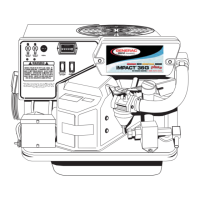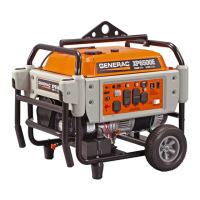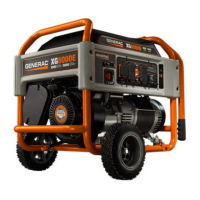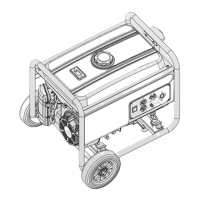Gaseous Fuel Systems
Installation Guidelines for Spark-Ignited Stationary Emergency Generators 25
To size an LP tank for a desired run time the following information is required:
• The maximum vapor consumption of the generator (in BTU/hr) at 100% load. The specification sheet for the gen-
erator will list the fuel consumption rate, usually in cubic feet per hour. To convert CFH to BTU/hr, multiply by
2520.
• The fuel consumption rate in gallons per hour with the generator at 100% load. To convert CFH (propane vapor)
to GPH, divide by 36.38. To convert BTU/hr to GPH, divide by 91502.
• The desired run time.
• The minimum operating temperature expected.
The most important thing to consider when sizing LP tanks for vapor withdrawal is the vaporization rate of the tank at
the minimum temperature expected, and at the minimum fuel level the tank will be allowed to reach. The vaporization
rates shown in Table 5-4 are based on the tank at 20% of its fill capacity.
1. Multiply the gallons per hour fuel consumption rate of the generator at 100% load by the longest run time
expected/desired.
2. Determine the fuel consumption in BTU/hr with the generator at 100% load.
3. Determine the lowest expected operating temperature.
4. See Table 5-4. Using both the Minimum Operating Temperature and the Tank Vaporization Capacity columns,
find the BTU/hr vaporization rate of the generator at 100% load that corresponds to the lowest expected operat-
ing temperature.
5.
Look back at column 2, note the Available Tank Capacity. If it is greater than the total run time fuel consumption
refer back to column 1- this is the correct size tank required. If it is less than the total run time fuel consumption,
then go to the next larger tank size. Recheck the lowest operating temperature and the tank vaporization capacity.
Table 5-4. Vaporization Rates
Tank Capacity
Total (gal)
See Note 1
Available Tank
Capacity (gal)
See Note 2
Minimum
Operating
Temperature
(º F)
Tank Vaporization
Capacity (BTU/hr)
See Note 3
Length
(In.)
Diameter
(In.)
250 150
40
20
0
507,600
338,400
169,200
94 30
325 195
40
20
0
642,600
428,400
214,200
119 30
500 300
40
20
0
792,540
528,360
264,180
119 37
850 510
40
20
0
1,217,700
811,800
405,900
165 41
1000 600
40
20
0
1,416,960
944,640
472,620
192 41
Note 1: The minimum LP tank size is 250 gallons, unless unit calculations dictate use of a larger tank. Vertical tanks, which are
measured in pounds, will not usually meet the minimum tank size (250 Gallons x 4.20 Pounds = approximately a 1050
pound vertical tank minimum).
Note 2: The available tank capacity is approximately 60% of the total fill capacity. This is based on a maximum fill level of 80%
and a minimum operating level of 20% (80%-20% = 60%).
Note 3: The vaporization capacity shown is based on a tank level of 20%. This represents the smallest allowable wetted surface
area of the liquid in the tank. As the liquid level goes up, the wetted surface area and the vaporization rate increases.
